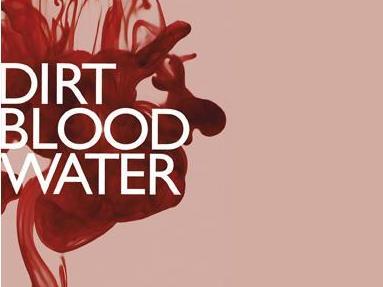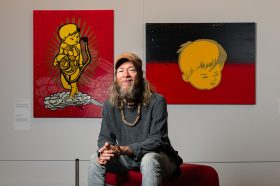It is a curious question and a conceptual one explored during a recent workshop – or “creative incubator” as it was called – at Bundanon in NSW organised in partnership with Sydney Harbour Foreshore Authority (SHFA).
The first step in a collaborative project with Glasgow Life / Merchant City Festival in Scotland and Urbane Kunste Ruhr in Germany, and with the loose title Dirt, Blood and Water, it is envisaged a large-scale water-based public style pavilion “artwork” (a truncated idea in itself) will be presented in the three cities.
This is no mean feat, as one of the three curators Michael Cohen, Creative Producer at SHFA, said: ‘I encourage you to not stick on the semantics too much.’
‘It could have just been “a concept” that we travelled around in an overnight bag. As it turns out, I think it will be an object of some sort – an interactive project – “pavilion” is a hint of where we are going, probably built in Sydney and then toured to the other two locations.’
He added, ‘We are talking about a workable plan of 2015/16, with the historical reverberation around the centenary of The Great War.’
Cohen is joined by curators Katja Aßmann (Germany) and Lorenzo Mele (Scotland) together with Australian artists Robyn Backen, Nigel Helyer and Jennifer Turpin; Andre Dekker from The Netherlands and Graham Eatough from Scotland.
Helyer noted that sitting down to tackle the notion of site specificity there were more commonalities than differences, given that in our globalised art world the definitions were commonly shared.
He said: ‘If I look at semantics for a minute – it is not touring in a theatrical sense, which I don’t think is such a contradiction, and our process has drawn that out. We have tried to concentrate on each of the three sites, so we haven’t been making a generic work that can slot in anywhere.’
How then do you make a work for three sites at once, especially given this water-based project will need to respond to very different environmental conditions before any other consideration – simply the difference in tide, water speed and wide-side infrastructures vary greatly between Sydney’s Darling Harbour, the Clyde River and Ruhr.
Furthermore these locations are in very different places along the timeline of gentrification as Helyer described, ‘Darling Harbour is kind of playground Disneyland type of environment, the Ruhr is still very evident of its mining and industrial history, and the Clyde, which was a major trading port and massive ship building site, is a site that hasn’t completely transformed itself – it hasn’t got the same economic drive we have in Sydney.’
How do you engage that thematic in the process of collaborating and generating new work that makes sense in each of these locations?
Dekker said, ‘If we want to work for all the sites that are so completely different, you need some sort of an enclosure. If we have an open artwork and see everything going on around it – Darling Harbor, Ruhr’s vast abandoned spaces, or a city that has turned its back to a river with Clyde – you are lost.’
Dekker said that it was important for the group to resolve how to have a private experience in a very public artwork.
Turpin said that what emerged in the groups dialogue was the, ‘The idea of creating an artwork that is less about the object and more about the experience that the audience or participant can have with, or in, the work.’
It is an interesting resolution to site differentiation.
Cohen added that the starting point, thematically, was ‘the common meeting ground is around looking after towns and cities that are on the edge of waterfronts, and how that interaction of landscape and waterscape is made active and interesting.’
Add to that the theme of the Great War, notions of memory and introspection, enclosure and connectivity, engineer’s reports and still no confirmation of budget, and the outcome after ten days of “think-tanking” rests in the conclusive idea that, ‘The object, the experience and the narrative are all tied together.’
Suddenly, site becomes a backdrop to these things, or does it?
How the experience of the site remains tightly woven into this project will be key to its success, as is with any public art project. These are all seasoned artists who know well the constraints of public works, and also the need to be pliable in the delivery of the work to site.
Do you think such a work can maintain its integrity as site-specific and responsive to those communities – we would be interesting in your opinion.
Thinking collaboratively
While experimental at one level – and a delightful proposition semantically – this really is a classic example of collaboration and transportability, two words that are frequently used to describe the peripatetic practice of our 21st century artists.
What makes this project different? And how do you start to reign the scope in to a workable model?
Helyer said: ‘Having three curators who have an agenda and a set of constraints – conceptual, cultural and logistic-economic – are very useful for the creative process. It gives edges; it gives direction.’
The artists were given three initial criteria: that the projects should be 1 – 2 months duration; it should be on or adjacent to the water and that it should fit all three sites, and that all key infrastructure must fit into x 3 air travel personal language.
Yeah? Anyone who has travelled with an exhibition in their suitcase knows well you can’t fit a pavilion in.
Helyer added, ‘The good thing about this iterative process is we can change the constraints – call it a dialectic process between the kind of curatorial direction and the collective imagining of the artists.’
Turpin agreed. She explained, ‘Everyone was thinking on their feet. The next day was only invented the night before.’
Backen joined in, ‘We had to learn very fast how to be open, how to critique, and how to accept ideas. In the end you didn’t know which idea was yours and which idea was there’s – it became a complete mash.’
Realities
So we have a pavilion, a narrative bundled up with memory, five very seasoned artists, and three watery sites. Let be optimistic and tick great idea and freight off the list as resolved. What, then, about the budget to make this thing real? The mind reels faster than a slot machine when one thinks of financing such a project.
Cohen said: ‘In the short term we are still looking for funding for the production of this project. This is very much the beginning – the brainstorming – and the development phase will be a whole other process and level of detail that these five artists will be driving.’
It should be mentioned it was not all pie-in-the-sky chat ups. The Bundanon incubator bought together experts in fields as diverse as urban planning, geography, maritime history and technology to start to flesh out some of the logistics with the artists.
Aßmann added, ‘We were all freedom in the beginning to come up with ideas. That was important. Now we are really going into budging them and then find partners to finance it.’
The cynic might suggest that by tapping into the WWI centenary that opens the project to a greater pool of funding. But there are many narratives that connect these three historically working water cities.
It leaves one wondering of this project what will resonant most strongly – the Great War or an amazing project about site and collaboration that challenges the notions of site-responsive public artwork?





